Biology: Unit 2
Unit 2 Day 1: Studying Cells in a Laboratory Setting and Cell Types
Overview:
Cell Theory:
- All organisms are made of cells
- The cell is the smallest unit of life
- All cells come from pre-existing cells
■ Remember….cell structure is correlated to cellular function
Studying Cells in a Lab
Microscopy
Why do scientists use microscopes? → To visualize cells too small to see with the naked eye and study their complexity
Types of Microscopes
Light Microscope (LM) - Visible light passes through a specimen and then through glass lesnses, which magnify the image
Image quality depends on…
○ ==Magnification==: The ratio of an objects image size to its real size
○ ==Resolution==: The measure of the clarity of the image
○ ==Contrast==: Visible differences in parts of the sample
■ LMs can magnify effectively to about 1,000 times
What are the limitations of LMs? → Organelles are too small to be resolved (focused) by an LM
Electron Microscopes (EMs)
Types:
Scanning Electron Microscopes (SEMs) - Focus a beam of electrons onto the surface of a specimen, proving images that look 3D
Transmission Electron Microscopes (TEMs) - Used to study the internal structure of a cell
What are the limitations of EMs? → Cannot observe living cells
Cell Fractionation
What does cell fractionation do? → Takes cells apart and separates the major organelles from one another
What tool is used to seperate cells into their component parts? → Ultracentrifuge
Cell Types
■ There are two types of cells: prokaryotes and eukaryotes
| Prokaryotic Cells | All Cells | Eukaryotic Cells |
|---|---|---|
| No nucleus | Are bound by a plasma membrane | DNA in a nucleus that is bound by a membranous nuclear envelope |
| DNA in an unbound region called the nucleoid | Contain Cytosol (Cytoplasm) | Membrane-bound organelles |
| No membrane-bound organelles | Contain chromosomes (carry genes) | Larger than Prokaryotic Cells |
| Typically small | Contain ribosomes (make proteins) | Multicellular |
| Unicellular | ||
| Ex: Bacteria | Ex: Animals, plants, fungi, and protists |
What does compartmentalization do? → Allows for different reactions in different locations
What does it prevent? → Prevents interfering reactions from occurring in the same locations
- - -
The Endomembrane system
■ The Endomembrane System regulates protein traffic and performs metabolic functions
Components of the endomembrane system:
- Nuclear envelope
- Endoplasmic Reticulum (ER)
- Golgi Apparatus
- Lysosomes
- Vacuoles
- Plasma Membrane
How are these components connected? → They are connected continuously (already connected) or are connected via the transfer of vesicles
The eukaryotic cell’s genetic instructions are housed in the nucleus and carried out by the ribosomes
Nucleus
Contains chromosomes
Enclosed in a nuclear envelope
Double Membrane
Has pore
Regulates entry and exit of materials
Contains a nucleolus
Nucleolus is a dense region of the nucleus that makes ribosomes
Exits via nuclear pores
How are ribosomes formed? → rRNA and proteins make ribosomes
What do ribosomes do with eh mRNA message? → They translate message to the primary structure of proteins (Amino Acids)
Ribosomes
Function: Make proteins
Locations:
Cytosol: Free ribosomes are located in the Cytosol (Cytoplasm)
Bound on the outside of the endoplasmic reticulum or the nuclear envelope
Endoplasmic Reticulum
■ A network of membranous sacs and tubes
Functions:
- Makes membranes
- Compartmentalize (separates) the cell to keep proteins formed in the rough Er seperate from those of free ribosomes
- Two Types: Rough Endoplasmic Reticulum and Smooth Endoplasmic Reticulum
Smooth ER
- Lacks ribosomes
- Makes lipids
- Metabolizes carbohydrates (Breaks Carbs down)
- Detoxifies poison
- Stores calcium
Rough ER
Has bound ribosomes which secrete glycoproteins
Glycoproteins are proteins bonded to carbohydrates
Distributes transport vesicles, proteins surrounded by membranes
Golgi Apparatus
■ Consists of flatted membranous sacs called Golgi Apparatus
- Has directionality
Cis Face: Receives vesicles from the ER
- Faces ER
Trans Face: Sends vesicles back out into the cytosol to other locations or to the plasma membrane for secretion
- Faces plasma membrane
Functions:
Receives transport vesicles with materials from the ER
Modifies materials
Sorts materials
Adds molecular tag
Packages materials into new transport vehicles that exit the membrane via exocytosis
(Exo - Exit, Cytosis - Cell)
Lysosomes
■ Membranous sacs of hydrolytic enzymes that digest macromolecules
Function:
- Can hydrolyze proteins, fats, polysaccharides, and nucleic acid
○ ==Phagocytosis==: Cellular eating (A cell engulfs another cell)
○ ==Autophagy==: Cells eat itself for renewal (Breaks down own components)
Peroxisomes
Similar to lysosomes
Membrane bound metabolic component
Catalyze reactions that produce H²O² (Hydrogen Peroxide)
Enzymes in peroxisomes then break down H²O² to water
Vacuoles
■ Large vesicles that stem from the ER and Golgi
Types:
- %%Food Vacuole%%: Formed by phagocytosis and digested by lysosomes
- %%Contractile Vacuole%%: Pump excess water out of cells
- Found in freshwater protists
- %%Central Vacuole%%: Hold inorganic ions and water
- Found in many mature plant cells
- Important for turgor pressure (Holds water in plant cells)
- - -
Energy Organelles
○ ==Endosymboint Theory==: The theory that explains the similarities mitochondria and chloroplasts have to a prokaryotes
■ Theory that states an early eukaryotic cell engulfed a prokaryotic cell
■ Prokaryotic cell became an endosyboint (cell that lives in another cell)
Evidence:
- Double membrane
- Ribosomes
- Circular DNA
- Capable of functioning on their own
Mitochondria
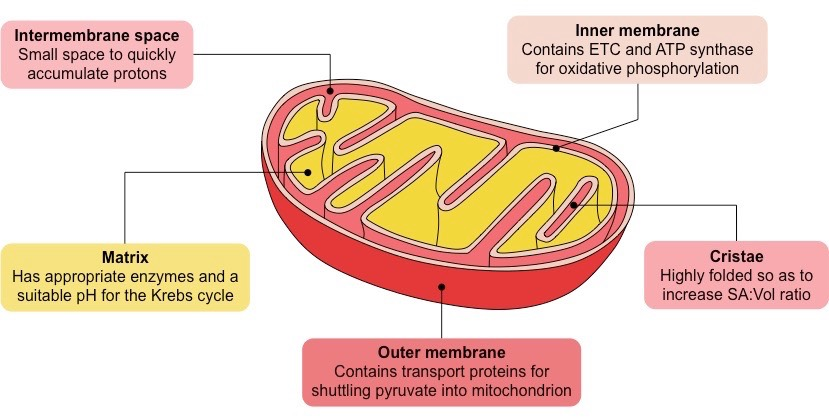
Function: Site of cellular respiration, a metabolic process that generates ATP energy
■ ATP Energy = Usable Energy
Structure of the double membrane: Has a smooth outer membrane and inner membrane is folded into Cristae (<------ The electron transport chain)
%%Intermembrane%%: Space between inner and outer membrane
%%Mitochondrial Matrix%%: Enclosed by the inner membrane
Location for the Krebs Cycle
Contains:
- Enzymes that catalyze cellular respiration and ATP energy
- Mitochondrial DNA
- Ribosomes
■ The number of mitochondria in a cell correlated with metabolic activity
- Cells with high metabolic activity have more mitochondria
^^Ex^^: Cells that move/contract (Muscles in humans)
Chloroplasts
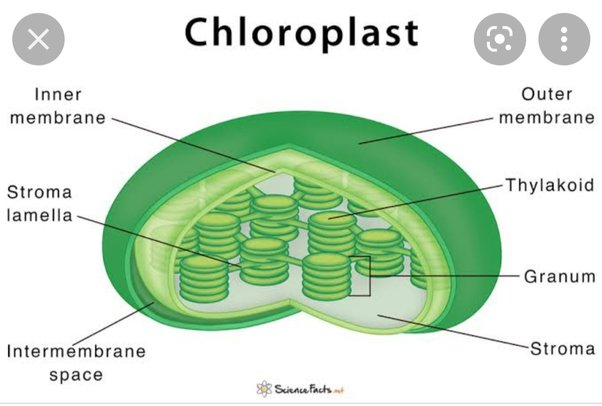
Found in the leaves of plants and algae, are the sites of photosynthesis
- %%Chlorophyll%%: Green pigment in plants (absorbs light energy)
Inside of its double membrane:
- %%Thylakoids%%
- Membranous sacs that can organize into stacks called Granum
- %%Stroma%%: The internal fluid
- Calvin Cycle occurs here
- - -
The Cytoskeleton
The Cytoskeleton
■ A network of fibers throughout the cytoplasm
Functions: Structural support (shape) and mechanical support (movement)
There are three types of fibers in the cytoskeleton:
- Microtubules (Thickets of the three)
- Microfilaments (Thin and skinny)
- Intermediate Filaments (Smaller than Microtubules, but larger than Microfilaments)
Microtubules:
Functions:
- Shapes cell (structural support)
- Guides movements of organelles (Think: Tracks)
- Separates choromosomes during cell division
- Cell motility (i.s. Cilia and Flagellum)
Centrosomes and Centrioles
- The centriole is a “microtubule-organizing center”
- Separates chromosomes in animal cells
- Microtubules grow out from a centrosome
■ Only found in animal cells
Cilia and Flagella
- Microtubules control beating of Cilia and Flagella
- Cilia and Flagella have different beating patterns
Common Structure:
- Core of microtubules
- Anchored by a “basel body” (Thing attached to the cell membrane)
Dynein is a motor protein that drives the movements of cilium and flagellum
Microfilaments (Actin Filaments)
Functions:
- Maintains cell shape
- Bear tension
- Forms a 3D network called cortex (Supports shape)
- Assists in muscle contraction and cell motility
- Actin works with myosin to cause contraction
- Division of animal cells
○ Pseudopodia: Cellular extension of amoeba
○ Cytoplasmic Streaming: Circular flow of cytoplasm within cells
Intermediate Filaments:
Functions:
- Maintains cell shape
- Anchor nucleus and organelles
- Form the nuclear Lamina
- Lines the Nuclear Envelope
- - -
Cell Size
Cell Size
Cellular metabolism depends on cell size
Metabolism - How they break apart
■ Cell waste must leave
■ Dissipate thermal energy
■ Nutrients and other resources (chemical materials) must enter
At a certain size, it begins to be too difficult for a cell to regulate what comes in and what goes out of the plasma membrane
Surface Area to Volume
The size of a cell will dictate the function
Cells need a high surface area-to-volume ratio to optimize the exchange of material through the plasma membrane
Formulas
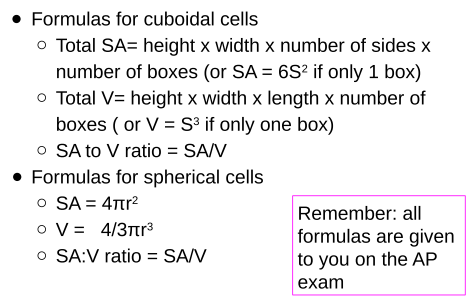
Example: Cubiodal Cell
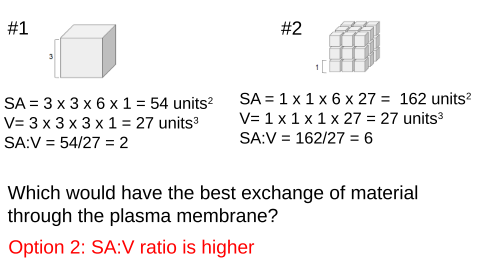
Example: Spherical Cell

Eukaryotic cells can reach above 100nm (nanometer) in diameter, while prokaryotic cells, like bacteria, remain small, reaching only to about 10nm in diameter. How are eukaryotic cells able to become so much larger than prokaryotic cells while still efficiently exchanging material through the plasma membrane?
What does this mean for a cell? →
Cells tend to be small
- Small cells have a high SA:V ratio
- Optimizes exchange of materials at the plasma membrane
- Larger cells have a lower SA:V ratio
- Lose efficiency exchanging materials
■ The cellular demand for resources increases
■ Rate of heat exchange decreases
- - -
Plasma Membrane and Membrane Permeability
Phospholipid Bilayer Structure
Phospholipid Bilayer: A double layer of phospholipids
■ Phospholipids are amphipathic molecules
○ ^^Amphipathic^^: Has both a hydrophobic region and a hydrophilic region
Examine the phospholipid to the right and identify the structures:
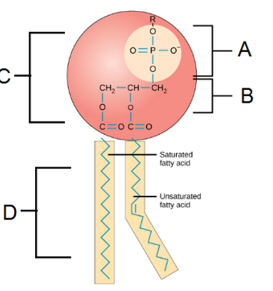
A: Phosphate Group
B: Glycerol
C: Hydrophilic Head
D: Hydrophobic Tails
■ A bilayer forms because they are amphipathic
■ Hydrophilic heads orient toward aqueous environments
■ Hydrophobic tails are facing inwards away from aqueous environments
Fluid Mosaic Model
A model to describe the structure of cell membranes
○ ^^Fluidity^^: Phospholipids are capable of movement
○ ^^Mosaic^^: Comprised of many macromolecules
Phospholipids
Cholesterol
Proteins
Carbohydrates
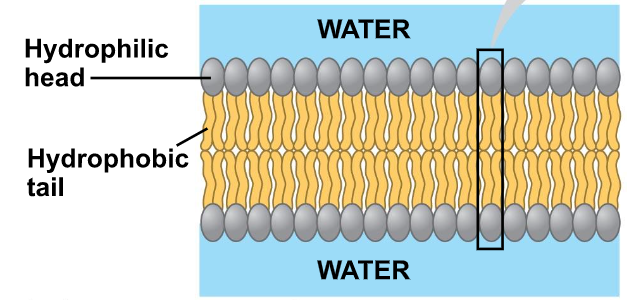
The fluidity of Membranes
○ ^^Fluid^^: Membrane is held together by weak hydrophobic interactions so phospholipids can move and shift
Which way do lipids drift? → Laterally/Rarely flip-flops transversely (Across the membrane)
Effects of Temperature on Fluidity
As temperatures cool, membranes switch from a fluid to a solid state
Which types of fatty acids are more fluid? Why? → Unsaturated fatty acids are more fluid than saturated fats due to kinks
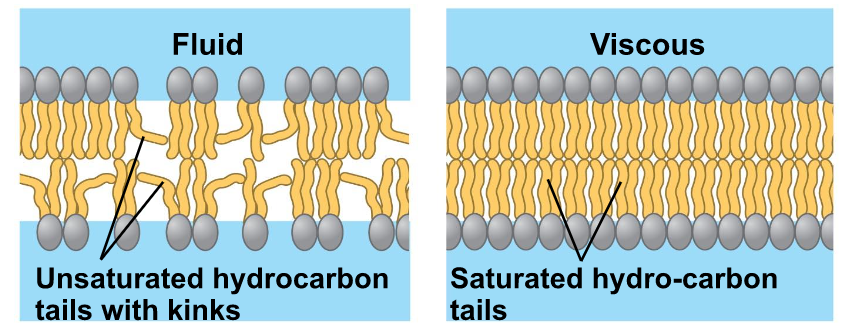
Cholesterol has different effects on membrane fluidity at different temperatures
- High Temp: Reduces movements
- Low Temp: Maintains fluidity by preventing tight packing
Membrane Proteins and Their Functions
Proteins determine most of the membrane’s specific functions
Categories:
- Integral proteins
- Embedded in the lipid bilayer
- Transmembrane proteins (spans the membrane)
- Amphipathic
- Peripheral Proteins
- Bound to the surface of the membrane
Membrane Carbohydrates
Important for cell-to-cell recognition
- Glycolipids
- Carbohydrates bonded to lipids
- Glycoproteins
- Carbohydrates bonded to proteins
- Most abundant
Draw and Label the cell membrane:

Membrane Functions
- Transport
- Enzymatic Activity
- Signal Transductions
- Cell-cell Recognition
- Intercellular Joining
- Attachment to the cytoskeleton and extracellular matrix (ECM)
Transport
A cell must exchange materials with its surroundings, a process controlled by the plasma membrane
○ ^^Selectively Permeable^^: Selectively letting some things pass through, but not others (like a screen)
Which types of molecules can pass through easily and rapidly? → Small hydrophobic (nonpolar) molecules
Which types of molecules cannot pass through easily and require assistance? → Large, hydrophilic (polar) molecules
Transport Proteins
Are transport proteins integral or peripheral? Integral
○ ^^Channel Proteins^^: Has a hydrophilic channel that is used as a tunnel
Ex: Aquaporins
○ ^^Carrier Proteins^^: Bind to molecules and change shape to shuttle them across the membrane
A transport protein is specific for the substance it moves
Plant Cell Barriers
Plants have a cell wall that covers their plasma membranes
Extracellular structure (not found in animal cells)
■ Made of cellulose
Provides:
- Shape/Structure
- Protection
- Regulation of water intake
Communication
Plants communicate through plasmodesmata
○ ^^Plasmodesmata^^: Hole-like structures in the cell wall filled with cytosol that connect adjacent cells
- - -
Passive Transport
Selective Permeability
Some substances can cross the membrane more easily than others
Easy passage across the membrane: small, hydrophobic (nonpolar) molecules
Difficult passage or protein assisted passage: Large hydrophilic (polar) molecules + ions
Transport Across a Membrane
There are two types of transport across a membrane: passive and active
○ ==Passive==: Without the use of energy
○ ==Active==: Uses energy
Passive Transport
Passive Transport:
■ Molecules move down their concentration gradient from high to low concentration
Diffusion:
○ ==Diffusion==: Molecules spread out evenly in the available space
■ Substances move from a high to a low concentration
■ Move with the concentration gradient
Dynamic Equilibrium:
■ Molecules diffuse directly across the membrane
■ Different rates of diffusion for different molecules
What factors impact the rate of diffusion? → Concentration gradient, distance, area, and the presence of transport proteins
Osmosis:
○ ==Osmosis==: The diffusion of water across a selectively permeable membrane
■ Osmosis can happen without a protein
■ Water diffused from a region of lower solute (high water) concentration to a region of higher solute (low water) concentration
Facilitated Diffusion:
==Facilitated Diffusion==: To help
■ Speeds up the rate of diffusion of: small ions, water, and carbohydrates
■ Two categories of transport proteins: channel and carrier
■ Each transport protein is specific for substances it can facilitate movement for
Channel Proteins:
==Channel Proteins==: Provides channels to allow specific molecules or ions to cross the membrane
■ Channel is hydrophilic
Which type of molecules pass through channel proteins? → Small polar molecules and ions
○ ==Aquaporins==: Proteins used for the facilitated diffusion of water
○ ==Gated channels==: Only open and close in response to stimulus
Carrier Proteins:
==Carrier Proteins==: Change shape that translocates the solute-binding site across the membrane
Which type of molecules pass through carrier proteins? → Lipid insoluble molecules